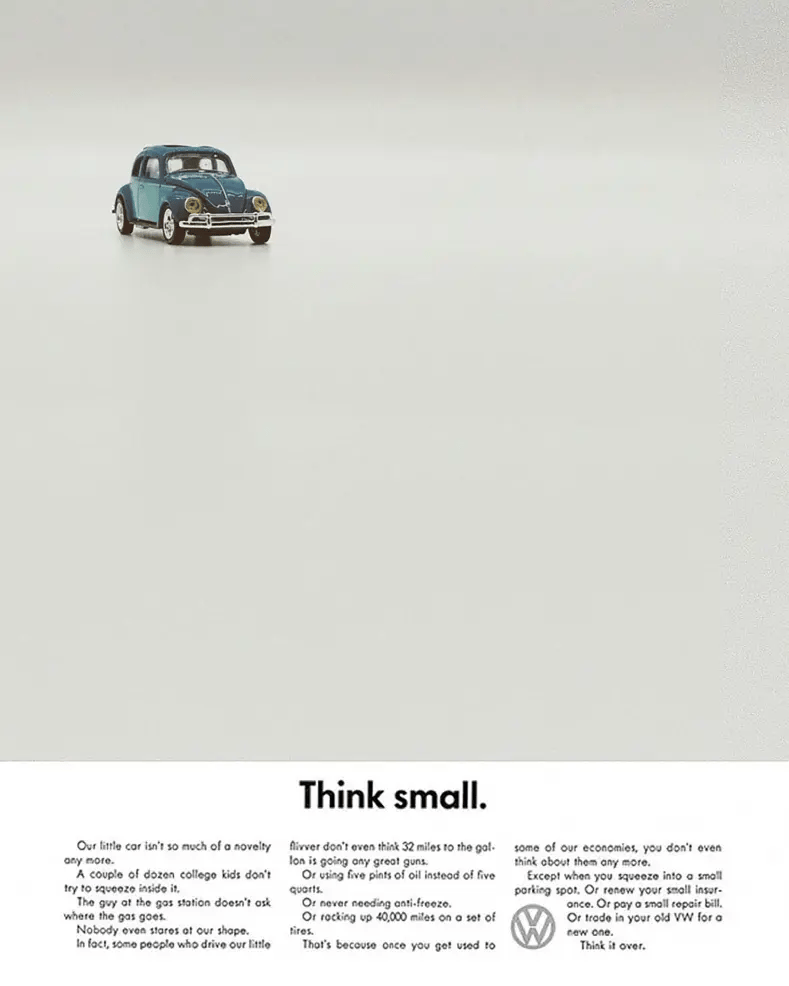Welcome folks to another edition of Write & Attract—where I bring you the best copywriting examples, website breakdowns, and marketing secrets to help you level up your writing game.
This week we’re diving into:
Three print ad copywriting masterpieces
Two website breakdowns (yes, Dropbox is here!)
One actionable marketing secret
Let’s Write, Let’s Attract.
Fact you didn't know: According to 87% of marketers, their companies' biggest underutilized asset is data. Agree?
3 Copywriting Examples
Example 1
Volkswagen

(Image credit: teamabovo)
Copy: Think Small.
Why It Works: Back in the 1960s, everyone wanted big cars. Bigger meant better, right? Volkswagen flipped the script with this bold, counterintuitive line. They embraced being the underdog, celebrated their compact design, and stood out by being unapologetically honest.
Takeaway: Be honest about what makes you different—and turn it into a strength.
Formula you can use: Think [Unexpected Twist]
Example 2
Absolut Vodka

(Image credit: adsoftheworld)
Copy: Absolut Perfection
Why It Works: Absolut didn’t just sell vodka—they sold a lifestyle. Their campaign turned the bottle into a cultural icon by keeping the message simple and pairing it with creative visuals. No clutter, no fluff, just pure confidence.
Takeaway: Sometimes, less is more. Let your product do the talking and pair it with bold simplicity.
Formula you can use: [Brand/Product] is [Superlative Quality]
Example 3
De Beers

(Image credit: Thedrum)
Copy: A Diamond is Forever.
Why It Works: This one didn’t just sell diamonds—it sold the idea of eternal love. By connecting their product to something timeless and emotional, De Beers didn’t just market jewelry. They created a tradition that’s still going strong today.
Takeaway: Tie your product to a deeper, emotional story that resonates with your audience.
Formula you can use: [Product] is [Emotional or Timeless Value].
2 Million Dollar Breakdown
Breakdown 1
Dropbox Dash

(Image credit: Dropbox Dash Homepage)
What Made It Work:
Direct and Relatable Messaging: “Find anything. Protect everything.” This line nails what users really care about: finding stuff fast and knowing it’s secure. No fluff. Just the essentials.
Simple, Powerful Promise: The focus is clear—Dropbox Dash helps you get work done quicker, all while keeping your files safe. The value is immediately delivered
Visual and Verbal Harmony: The short tutorial complements the copy, reinforcing the simplicity of the product. It’s not just about looking good—it’s about functionality making users feel like they’ve found the perfect tool.
Actionable Insight: Keep your messaging simple and show how your product fits into your customer’s life. When you solve a real problem, people will listen.
Why These Words?
“Find anything” speaks to the frustration of digging through endless folders or searching for files. It hits the productivity pain point hard.
“Protect everything” reassures users, tapping into Dropbox’s strong reputation for security. People trust them with their data, so they lean into it here.
Breakdown 2
Mailchimp

(Image: Mailchimp)
What Made It Work:
Benefit-Driven Messaging: The hero copy, “Turn Emails into Revenue,” speaks directly to the end goal of their audience: making money.
Credibility at a Glance: The website highlights success stories which immediately builds trust.
Relatable Tone: The conversational style appeals to small businesses and creators who see Mailchimp as a partner, not just a tool.
Actionable Insight: Focus on results. Your audience wants to know what’s in it for them, not how great your product is.
Why These Words?
“Turn Emails into Revenue” simplifies the value proposition. It’s direct, clear, and rooted in the customer’s ultimate goal.
This no-nonsense approach resonates with small businesses that don’t have time for jargon.
1 Marketing Secret
Reciprocity
What Made It Work?
Upfront Value: HubSpot offers a ton of free resources—like templates and tools—which creates a sense of obligation for their audience.
Building Trust: By giving away valuable content first, HubSpot positions themselves as a brand that genuinely wants to help, building trust with their audience.
Encouraging Loyalty: When people receive value, they’re more likely to engage and eventually become loyal customers.
Why It Works:
Psychological triggers like reciprocity make people feel compelled to return the favor. When you give, people are more likely to respond with engagement, loyalty, or even purchases down the line.
Winning Formula:
Free Value → Create helpful resources that solve real problems.
Trust Building → Focus on offering value without asking for anything in return.
Nurture Relationships → Let goodwill grow into long-term results and loyalty.
Over to You
What’s your favorite example from this week? Reply to this email—I’d love to hear your thoughts!
Also, if you’re enjoying this newsletter, don’t keep it to yourself. Forward it to a friend or colleague who’d find it valuable.
Until next Saturday, keep writing & attracting!

